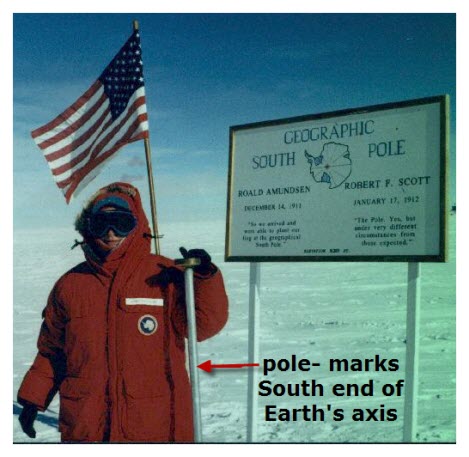I was invited to go to the South Pole by CARA (Center of Research in Antarctica), at the University of Chicago.
CARA is sponsored by the National Science Foundation, the objective of the trip was to encourage student interest in science as well as the science in Antarctica.
Information collected during this excursion served as the foundation for some of the experiments in my books.
My expedition to Antarctica was during December, 1997, which was summer in the Southern Hemisphere. I am use to the very warm Texas summer temperatures. The chilling pole temperature averaged about minus 20 degrees Fahrenheit. With wind chill, it felt like minus 50 degrees. The flag indicates that the wind was blowing when I posed for the picture. Makes me feel cold just looking at it. Burrr!
There is a physical pole stuck in the ice marking the spot where the south end of Earth’s imaginary axis exits the Earth. The ice the pole is stuck in moves about 10 meters each year. Instead of repositioning the pole, a new pole is put in place at the beginning of each new year. The old poles form what looks like a straight line of fence posts positioned about 10 m apart.
How far is ten meters?
Discover for yourself how far apart the poles are.
1. Measure 10 meters of string.
2. Tie each end of the string to a different color pencil, such as red and yellow.
3. Ask two people to stand side-by-side, each holding one of the pencils.
4. Ask the person with the yellow pencil to stand still.
This pencil (yellow) represents the Geographic South Pole, which is the south end of Earth’s imaginary axis running through the center of Earth. This end of the axis does not change position. The south end of Earth’s axis exits the same place on Earth day in and day out.
5. Ask the other person with the red pencil to slowly walk forward in a straight line until the string is taught.
This pencil (red) represents the physical pole stuck in the ice to mark the location of Earth’s Geographic South Pole. The pencil, like the actual marking poles at the South Pole, moves away from where the Earth’s axis exits. This is because the pole is stuck into a sheet of ice, and the ice moves about 10 m toward the ocean each year. As the ice moves, the marking pole moves with it.
